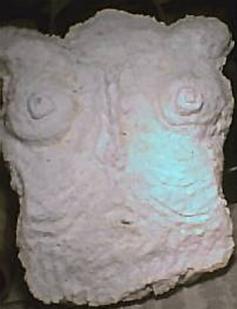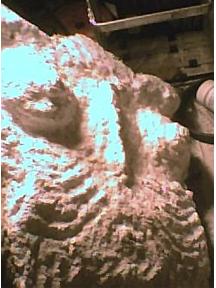Demeter or Bust

 On the hurdles inherent in creating a lawn goddess....
On the hurdles inherent in creating a lawn goddess....I got into paper pulp sculpting entirely by accident. Originally I wanted to make paper to use in collage, and consulted Nita Leland's and Virginia Lee Williams' wonderfully fun book Creative Collage Techniques. After reading their section on making handmade paper I set about ripping discarded office drafts, which I soaked in water and pulped in an old blender. I flattened the pulp on a window screen rescued from the curb and let excess water drain into the kitchen sink.
Discarded office paper, I learned, creates a speckly off-white sheet. Pulped newspaper produces a thinner, crisper gray.
My first piece that used the paper was not collage per se, but something I called Bird Shield. For the larger piece of free-form paper I threw some paint into the blender, which gave the sheet a smoother texture. It was also a fairly liberal use of paint, much of which drained away with the excess water. But I also experimented with embedding smaller feathers and grass. The bird was my not-completely-successful attempt to create a transfer film, in which one uses clear acrylic (in this case gloss medium) to lift and transfer a ghost image onto another surface: my bird wasn't quite ready to give up the ghost. I used gloss gel to affix the larger pigeon feathers and glass piece, along with the hanging mechanism of alizarin crimson-painted rope and chopstick.

 Bird Shield hung in my office for a few years, and someone commented that it was heavier than it looked. That should have given me a clue. Paper is dense. Paper with added acrylic is heavier.
Bird Shield hung in my office for a few years, and someone commented that it was heavier than it looked. That should have given me a clue. Paper is dense. Paper with added acrylic is heavier.I also discovered that, with acrylic paint and its adhesive qualities added to the mix, I could take pulped, colored paper and make it into shapes that held together. That's when the sculpting started. I no longer flattened my pulp on a screen but mixed it with gesso -- usually used to prime a painter's canvas -- to create what seemed a messy white clay that I could shape. Instead of dumping colored paint into my blender I dumped it into a bowl, using less of it to tint already-drained pulp.

 Crone Goddess was my first sculpture, done before I realized I didn't need to put paint in the blender. Soon afterward, Conjuring Goddess gave me my first experience with accommodating gravity. To keep her arms raised meant building supports of Jello boxes covered with wax paper on which I then sculpted the limbs.
Crone Goddess was my first sculpture, done before I realized I didn't need to put paint in the blender. Soon afterward, Conjuring Goddess gave me my first experience with accommodating gravity. To keep her arms raised meant building supports of Jello boxes covered with wax paper on which I then sculpted the limbs.My first standing figure, Amazon, followed. (Her arrows are painted toothpicks fletched with bits of pigeon feather.) To get her to hold together I had to fashion her in pieces -- in a sense creating my own armature and then building outward from it.

 When we moved here a "lawn" of sand blasted Mary's legs as she explored the yard. Any trees that had once graced the property had been cut down. Almost three years later the sand is mostly gone; our gully is filled; and we have a variety of young trees, shrubs, and volunteer plants that make the place look lively. But in the beginning I wasn't sure how we'd fare.
When we moved here a "lawn" of sand blasted Mary's legs as she explored the yard. Any trees that had once graced the property had been cut down. Almost three years later the sand is mostly gone; our gully is filled; and we have a variety of young trees, shrubs, and volunteer plants that make the place look lively. But in the beginning I wasn't sure how we'd fare.If ever there was a time to call in the gods, this was it. And who better than Demeter, the ancient Greek goddess of growing things? We had a nice little spot between our newly-planted dwarf elm and our honeysuckle-draped lamppost where I pictured her sitting, face tilted toward the sky and arms raised. I figured enough coats of gloss medium might help her withstand the weather. By this time I started painting my pieces after they had dried. Given the pulp's nubbly texture the coat wouldn't be as smooth, but I was willing to compromise.
Our neighbors had little fountains, pretty pools, and lawn jockeys. (We haven't yet seen plastic flamingos.) I saw no reason why we couldn't have a lawn goddess. I set myself the task to make a life-sized sculpture, and picked up some lovely gown material from the local fabric store so she wouldn't shock anyone. It didn't matter that I hadn't a clue about what to do.

Paper soaks in the pot, is pulped in the blender, and is squeezed out and pressed against the strainer while water drips into the yogurt container. The squeezed pulp (one filled blender yields about three handfuls) then gets torn into small bits and mixed with gesso before sculpting. Daisy inspects the process.
 I'd since gotten a crosscut paper shredder -- a tremendous time-saver -- and proceeded to create my pieces. The hand was easy enough because it was small. The bust had to be done in about a dozen layers, each requiring hours of pulping and sculpting followed by days of drying time. And that's when I learned how much difference humidity makes.
I'd since gotten a crosscut paper shredder -- a tremendous time-saver -- and proceeded to create my pieces. The hand was easy enough because it was small. The bust had to be done in about a dozen layers, each requiring hours of pulping and sculpting followed by days of drying time. And that's when I learned how much difference humidity makes.
 Though still skeletal -- surely the goddess of fertility is more zaftig than that -- the bust has its basic form. Theoretically, outer layers would then attach it to arms, neck/head, and pelvis.
Though still skeletal -- surely the goddess of fertility is more zaftig than that -- the bust has its basic form. Theoretically, outer layers would then attach it to arms, neck/head, and pelvis.Theoretically. Until the mold moved in, spreading dark spots on my handiwork. I answered with an arsenal of rubbing alcohol and hydrogen peroxide, followed by an additional coat of gesso. By this time I was also a couple of layers into building Demeter's derriere, barely enough for a cheeky curve. Thinner layers. Given enough time for each to become bone-dry, perhaps they'd thwart the microorganisms.
Even if I could conquer the mold there was still the matter of density. That anorexic bust alone tips the scale at ten pounds. When I gave it to someone to heft and he was afraid he'd drop it I assured him the piece was hard enough to withstand a pounding. If I completed a full-sized sculpture, would I even be able to move it?
I've done other sculptures down here to better effect. Spring mixes smaller pieces of pulp with other materials. For now the fabric for Demeter's gown still sits in its bag on my closet shelf and her partial butt still sits on my dresser. Maybe some day, when the spirit moves me or the yard begs for divine intervention, I will resume building her.











1 Comments:
Wow...you would fit right in here in Floyd. Here is my friend Jayn's website: http://sculpturesbyjayn.com/ She's mostly a potter but also does sculpture similiar to yours.
The boutique I was a live mannequin for is no longer there. It was on Tremont Street right in front of Boston Commons (or was it Gardens) called the Riverboat. I worked there and it was in 1969!
Post a Comment
<< Home